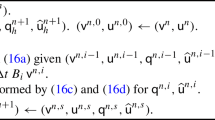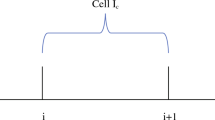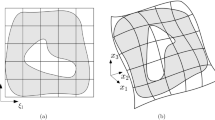Abstract
This paper deals with a high-order \(H({\text {curl}})\)-conforming Bernstein–Bézier finite element method (BBFEM) to accurately solve time-harmonic Maxwell short wave problems on unstructured triangular mesh grids. We suggest enhanced basis functions, defined on the reference triangle and tetrahedron, aiming to reduce the condition number of the resulting global matrix. Moreover, element-level static condensation of the interior degrees of freedom is performed in order to reduce memory requirements. The performance of BBFEM is assessed using several benchmark tests. A preliminary analysis is first conducted to highlight the advantage of the suggested basis functions in improving the conditioning. Numerical results dealing with the electromagnetic scattering from a perfect electric conductor demonstrate the effectiveness of BBFEM in mitigating the pollution effect and its efficiency in capturing high-order evanescent wave modes. Electromagnetic wave scattering by a circular dielectric, with high wave speed contrast, is also investigated. The interior curved interface between layers is accurately described based on a linear blending map to avoid numerical errors due to geometry description. The achieved results support our expectations for highly accurate and efficient BBFEM for time harmonic wave problems.












Similar content being viewed by others
Data availability
Enquiries about data availability should be directed to the authors.
References
Nédélec, J.C.: Mixed finite elements in \({\mathbb{R} }^{3}\). Numer. Math. 35(3), 315–341 (1980)
Nédélec, J.C.: A new family of mixed finite elements in \({\mathbb{R} }^{3}\). Numer. Math. 50(1), 57–81 (1986)
Barton, M.L., Cendes, Z.J.: New vector finite elements for three-dimensional magnetic field computation. J. Appl. Phys. 61(8), 3919–3921 (1987)
Bespalov, A.N.: Finite element method for the eigenmode problem of a RF cavity resonator (1988)
Lee, J.F., Sun, D.K., Cendes, Z.J.: Tangential vector finite elements for electromagnetic field computation. IEEE Trans. Magn. 27(5), 4032–4035 (1991)
Ahagon, A., Fujiwara, K., Nakata, T.: Comparison of various kinds of edge elements for electromagnetic field analysis. IEEE Trans. Magn. 32(3), 898–901 (1996)
Whitney, H.: Geometric Integration Theory. Princeton University Press, Princeton (1957)
Bossavit, A., Verite, J.C.: A mixed FEM-BIEM method to solve 3-D eddy-current problems. IEEE Trans. Magn. 18(2), 431–435 (1982)
Bossavit, A., Verite, J.C.: The TRIFOU code: Solving the 3-D eddy-currents problem by using H as state variable. IEEE Trans. Magn. 19(6), 2465–2470 (1983)
Bossavit, A.: Whitney forms: a class of finite elements for three-dimensional computations in electromagnetism. IEE Proc. A Phys. Sci. Meas. Instrum. Manag. Educ. Rev. 135(8), 493–500 (1988)
Bossavit, A.: A rationale for edge-elements in 3-D fields computations. IEEE Trans. Magn. 24(1), 74–79 (1988)
Bossavit, A., Mayergoyz, I.: Edge elements for scattering problems. IEEE Trans. Magn. 25(4), 2816–2821 (1989)
Mur, G., De Hoop, A.: A finite element method for computing three-dimensional electromagnetic fields in inhomogeneous media. IEEE Trans. Magn. 21(6), 2188–2191 (1985)
Cendes, Z.J.: Vector finite elements for electromagnetic field computation. IEEE Trans. Magn. 27(5), 3958–3966 (1991)
Webb, J.P., Forgahani, B.: Hierarchal scalar and vector tetrahedra. IEEE Trans. Magn. 29(2), 1495–1498 (1993)
Geuzaine, C., Meys, B., Dular, P., Legros, W.: Convergence of high order curl-conforming finite elements [for EM field calculations]. IEEE Trans. Magn. 35(3), 1442–1445 (1999)
Graglia, R.D., Wilton, D.R., Peterson, A.F.: Higher-order interpolatory vector bases for computational electromagnetics. IEEE Trans. Antennas Propag. 45(3), 329–342 (1997)
Webb, J.P.: Hierarchal vector basis functions of arbitrary order for triangular and tetrahedral finite elements. IEEE Trans. Antennas Propag. 47(8), 1244–1253 (1999)
Díaz-Morcillo, A., Jin, J. M.: A comparison of hierarchical and interpolatory basis functions in the finite element analysis of waveguiding structures. In: IEEE Antennas and Propagation Society International Symposium (IEEE Cat. No. 02CH37313), vol. 4, pp. 710–713. IEEE (2002)
Ainsworth, M., Coyle, J.: Hierarchic \(hp\)-edge element families for Maxwell’s equations on hybrid quadrilateral/triangular meshes. Comput. Methods Appl. Mech. Eng. 190(49–50), 6709–6733 (2001)
Ainsworth, M., Coyle, J.: Hierarchic finite element bases on unstructured tetrahedral meshes. Int. J. Numer. Methods Eng. 58(14), 2103–2130 (2003)
Ingelstrom, P.: A new set of H (curl)-conforming hierarchical basis functions for tetrahedral meshes. IEEE Trans. Microw. Theory Tech. 54(1), 106–114 (2006)
Jorgensen, E., Volakis, J.L., Meincke, P., Breinbjerg, O.: Higher-order hierarchical Legendre basis functions for electromagnetic modeling. IEEE Trans. Antennas Propag. 52(11), 2985–2995 (2004)
Rachowicz, W., Demkowicz, L.F.: An \(hp\)-adaptive finite element method for electromagnetics-part II: a 3D implementation. Int. J. Numer. Methods Eng. 53(1), 147–180 (2002)
Schöberl, J., Zaglmayr, S.: High-order Nédélec elements with local complete sequence properties. COMPEL Int. J. Comput. Math. Electr. Electron. Eng. 24(2), 374–384 (2005)
Sun, D.K., Lee, J.F., Cendes, Z.J.: Construction of nearly orthogonal Nédélec bases for rapid convergence with multilevel preconditioned solvers. SIAM J. Sci. Comput. 23(4), 1053–1076 (2001)
Abdul-Rahman, R., Kasper, M.: Orthogonal hierarchical Nédélec elements. IEEE Trans. Magn. 44(6), 1210–1213 (2008)
Graglia, R.D., Peterson, A.F., Andriulli, F.P.: Curl-conforming hierarchical vector bases for triangles and tetrahedra. IEEE Trans. Antennas Propag. 59(3), 950–959 (2010)
Perugia, I., Schötzau, D., Monk, P.: Stabilized interior penalty methods for the time-harmonic Maxwell equations. Comput. Methods Appl. Mech. Eng. 191(41–42), 4675–4697 (2002)
Hesthaven, J.S., Warburton, T.: High-order nodal discontinuous Galerkin methods for the Maxwell eigenvalue problem. Philos. Trans. R. Soc. Lond. Ser. A Math. Phys. Eng. Sci. 362(1816), 493–524 (2004)
Houston, P., Perugia, I., Schneebeli, A., Schötzau, D.: Mixed discontinuous Galerkin approximation of the Maxwell operator: the indefinite case. ESAIM Math. Model. Numer. Anal. 39(4), 727–753 (2005)
Houston, P., Perugia, I., Schneebeli, A., Schötzau, D.: Interior penalty method for the indefinite time-harmonic Maxwell equations. Numer. Math. 100(3), 485–518 (2005)
Buffa, A., Perugia, I.: Discontinuous Galerkin approximation of the Maxwell eigenproblem. SIAM J. Numer. Anal. 44(5), 2198–2226 (2006)
Warburton, T., Embree, M.: The role of the penalty in the local discontinuous Galerkin method for Maxwell’s eigenvalue problem. Comput. Methods Appl. Mech. Eng. 195(25–28), 3205–3223 (2006)
Lohrengel, S., Nicaise, S.: A discontinuous Galerkin method on refined meshes for the two-dimensional time-harmonic Maxwell equations in composite materials. J. Comput. Appl. Math. 206(1), 27–54 (2007)
Dolean, V., Fol, H., Lanteri, S., Perrussel, R.: Solution of the time-harmonic Maxwell equations using discontinuous Galerkin methods. J. Comput. Appl. Math. 218(2), 435–445 (2008)
El Bouajaji, M., Lanteri, S.: High order discontinuous Galerkin method for the solution of 2D time-harmonic Maxwell’s equations. Appl. Math. Comput. 219(13), 7241–7251 (2013)
Hiptmair, R., Moiola, A., Perugia, I.: Error analysis of Trefftz-discontinuous Galerkin methods for the time-harmonic Maxwell equations. Math. Comput. 82(281), 247–268 (2013)
Nguyen, N.C., Peraire, J., Cockburn, B.: Hybridizable discontinuous Galerkin methods for the time-harmonic Maxwell’s equations. J. Comput. Phys. 230(19), 7151–7175 (2011)
Li, L., Lanteri, S., Perrussel, R.: Numerical investigation of a high order hybridizable discontinuous Galerkin method for 2D time-harmonic Maxwell’s equations. COMPEL Int. J. Comput. Math. Electr. Electron. Eng. (2013)
Li, L., Lanteri, S., Perrussel, R.: A class of locally well-posed hybridizable discontinuous Galerkin methods for the solution of time-harmonic Maxwell’s equations. Comput. Phys. Commun. 192, 23–31 (2015)
Lu, P., Chen, H., Qiu, W.: An absolutely stable \(hp\)-HDG method for the time-harmonic Maxwell equations with high wave number. Math. Comput. 86(306), 1553–1577 (2017)
Zhu, L., Huang, T.Z., Li, L.: A hybrid-mesh hybridizable discontinuous Galerkin method for solving the time-harmonic Maxwell’s equations. Appl. Math. Lett. 68, 109–116 (2017)
Agullo, E., Giraud, L., Gobé, A., Kuhn, M., Lanteri, S., Moya, L.: High order HDG method and domain decomposition solvers for frequency-domain electromagnetics. Int. J. Numer. Model. Electron. Networks Devices Fields 33(2), e2678 (2020)
Lai, M.J., Schumaker, L.L.: Spline Functions on Triangulations, vol. 110. Cambridge University Press, Cambridge (2007)
Ainsworth, M., Andriamaro, M.G., Davydov, O.: Bernstein-Bézier finite elements of arbitrary order and optimal assembly procedures. SIAM J. Sci. Comput. 33(6), 3087–3109 (2011)
Lohmann, C., Kuzmin, D., Shadid, J.N., Mabuza, S.: Flux-corrected transport algorithms for continuous Galerkin methods based on high order Bernstein finite elements. J. Comput. Phys. 344, 151–186 (2017)
El Kacimi, A., Laghrouche, O., Mohamed, M.S., Trevelyan, J.: Bernstein-Bézier based finite elements for efficient solution of short wave problems. Comput. Methods Appl. Mech. Eng. 343, 166–185 (2019)
El Kacimi, A., Laghrouche, O., Ouazar, D., Mohamed, M.S., Seaid, M., Trevelyan, J.: Enhanced conformal perfectly matched layers for Bernstein–Bézier finite element modelling of short wave scattering. Comput. Methods Appl. Mech. Eng. 355, 614–638 (2019)
Peng, X., Xu, G., Zhou, A., Yang, Y., Ma, Z.: An adaptive Bernstein–Bézier finite element method for heat transfer analysis in welding. Adv. Eng. Softw. 148, 102–855 (2020)
Benatia, N., El Kacimi, A., Laghrouche, O., El Alaoui Talibi, M., Trevelyan, J.: Frequency domain Bernstein–Bézier finite element solver for modelling short waves in elastodynamics. Appl. Math. Model. 102, 115–136 (2022)
Engvall, L., Evans, J.A.: Isogeometric unstructured tetrahedral and mixed-element Bernstein–Bézier discretizations. Comput. Methods Appl. Mech. Eng. 319, 83–123 (2017)
Farouki, R., Goodman, T.: On the optimal stability of the Bernstein basis. Math. Comput. 65(216), 1553–1566 (1996)
Farouki, R.T.: The Bernstein polynomial basis: a centennial retrospective. Comput. Aided Geometric Des. 29(6), 379–419 (2012)
Kirby, R.C., Thinh, K.T.: Fast simplicial quadrature-based finite element operators using Bernstein polynomials. Numer. Math. 121(2), 261–279 (2012)
Kirby, R.C.: Low-complexity finite element algorithms for the de Rham complex on simplices. SIAM J. Sci. Comput. 36(2), A846–A868 (2014)
Ainsworth, M., Andriamaro, M.G., Davydov, O.: A Bernstein-Bézier basis for arbitrary order Raviart–Thomas finite elements. Constr. Approx. 41(1), 1–22 (2015)
Ainsworth, M., Fu, G.: Bernstein-Bézier bases for tetrahedral finite elements. Comput. Methods Appl. Mech. Eng. 340, 178–201 (2018)
Arnold, D.N., Falk, R.S., Winther, R.: Geometric decompositions and local bases for spaces of finite element differential forms. Comput. Methods Appl. Mech. Eng. 198(21–26), 1660–1672 (2009)
Gordon, W.J., Hall, C.A.: Construction of curvilinear coordinate systems and applications to mesh generation. Int. J. Numer. Methods Eng. 7(4), 461–477 (1973)
Gordon, W.J., Hall, C.A.: Transfinite element methods: blending-function interpolation over arbitrary curved element domains. Numer. Math. 21(2), 109–129 (1973)
Hiptmair, R., Moiola, A., Perugia, I.: Stability results for the time-harmonic Maxwell equations with impedance boundary conditions. Math. Models Methods Appl. Sci. 21(11), 2263–2287 (2011)
Colton, D., Kress, R.: Inverse Acoustic and Electromagnetic Scattering Theory, vol. 93. Springer Nature, Berlin (2019)
Monk, P.: Finite Element Methods for Maxwell’s Equations. Oxford University Press, Oxford (2003)
Demkowicz, L.F.: Finite element methods for Maxwell’s equations. Encyclopedia of Computational Mechanics, 2nd edn., pp. 1–20 (2017)
Nicaise, S., Tomezyk, J.: Convergence analysis of a \(hp\)-finite element approximation of the time-harmonic Maxwell equations with impedance boundary conditions in domains with an analytic boundary. Numer. Methods Partial Differ. Equ. 36(6), 1868–1903 (2020)
Kirsch, A., Monk, P.: A finite element/spectral method for approximating the time-harmonic Maxwell system in \({\mathbb{R} }^{3}\). SIAM J. Appl. Math. 55(5), 1324–1344 (1995)
Monk, P.: A finite element method for approximating the time-harmonic Maxwell equations. Numer. Math. 63(1), 243–261 (1992)
Rognes, M.E., Kirby, R.C., Logg, A.: Efficient assembly of H(div) and H(curl) conforming finite elements. SIAM J. Sci. Comput. 31(6), 4130–4151 (2010)
P. Ŝolín, Segeth, K., Dolezel, I.: Higher-Order Finite Element Methods. CRC Press, Cambridge (2003)
Boffi, D., Brezzi, F., Fortin, M.: Mixed Finite Element Methods and Applications, vol. 44. Springer, Berlin (2013)
Andriamaro, M.G.: Bernstein–Bézier techniques and optimal algorithms in finite element analysis. Ph.D. thesis, University of Strathclyde (2013)
Gopalakrishnan, J., García-Castillo, L.E., Demkowicz, L.F.: Nédélec spaces in affine coordinates. Comput. Math. Appl. 49(7), 1285–1294 (2005)
Szabó, B., Babuška, I.: Finite Element Analysis. Wiley, New York (1991)
Amestoy, P.R., Duff, I.S., L’excellent, J.Y.: Multifrontal parallel distributed symmetric and unsymmetric solvers. Comput. Methods Appl. Mech. Eng. 184(2–4), 501–520 (2000)
Jin, J.M.: Theory and Computation of Electromagnetic Fields. Wiley, New York (2015)
Dolean, V., Gander, M.J., Gerardo-Giorda, L.: Optimized Schwarz methods for Maxwell’s equations. SIAM J. Sci. Comput. 31(3), 2193–2213 (2009)
Rawat, V., Lee, J.F.: Nonoverlapping domain decomposition with second order transmission condition for the time-harmonic Maxwell’s equations. SIAM J. Sci. Comput. 32(6), 3584–3603 (2010)
El Bouajaji, M., Thierry, B., Antoine, X., Geuzaine, C.: A quasi-optimal domain decomposition algorithm for the time-harmonic Maxwell’s equations. J. Comput. Phys. 294, 38–57 (2015)
Acknowledgements
We would like to thank the Moroccan Ministry of Higher Education, Scientific Research and Innovation and the OCP Foundation who funded this work through the APRD research program.
Funding
The authors have not disclosed any funding.
Author information
Authors and Affiliations
Corresponding author
Ethics declarations
Competing interests
The authors have not disclosed any competing interests.
Additional information
Publisher's Note
Springer Nature remains neutral with regard to jurisdictional claims in published maps and institutional affiliations.
Rights and permissions
Springer Nature or its licensor (e.g. a society or other partner) holds exclusive rights to this article under a publishing agreement with the author(s) or other rightsholder(s); author self-archiving of the accepted manuscript version of this article is solely governed by the terms of such publishing agreement and applicable law.
About this article
Cite this article
Benatia, N., El Kacimi, A., Laghrouche, O. et al. Bernstein–Bézier \(H({\text {curl}})\)-Conforming Finite Elements for Time-Harmonic Electromagnetic Scattering Problems. J Sci Comput 97, 69 (2023). https://doi.org/10.1007/s10915-023-02381-5
Received:
Revised:
Accepted:
Published:
DOI: https://doi.org/10.1007/s10915-023-02381-5




